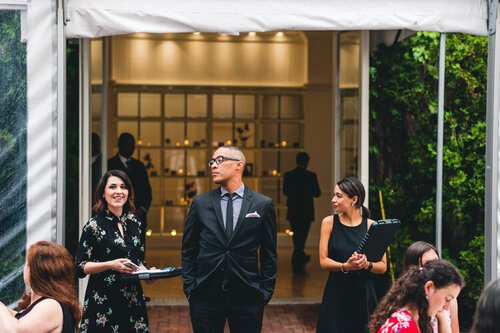THE PERKS OF A TENTED EVENT
In 2020 the traditional way of hosting a wedding or special event has been thrown out the window, and requires a little bit of creativity and non-traditional approach. We are seeing a lot more out-of-the-box versions of weddings; from your front stoop to your backyard. And honestly, we are so here for it! We love getting creative with our clients to create a more intimate vibe.
But what do these events have in common? They’re all being held outside. And while we love a good outdoor wedding, it can come with an extra layer of unexpected challenges, the biggest being the weather. While we wish we could pray to the weather gods to grant you a perfect clear day, that just isn’t possible. So, what’s a solution that will not only put your mind at ease but also create a more comfortable environment for your guests? TENTING.
Today, we’re talking about different tenting options as well as things to consider when planning a cozy tented al fresco dining experience for your guests.
First, let’s breakdown the most common types of tents.
Pole tents. Pole tents have peaks created by, you guessed it, center poles. Pole tents come in vinyl or sailcloth and provide a beautiful chic look. This style of tents must be staked in the ground, and therefore cannot be setup on concrete or other hard surfaces.
Structured and framed tents. A structured or framed tent is one of the most common types of tents. These use metal frames to support the tent and are free standing, therefore can be set up on most surfaces. These tents definitely have more versatility. The exposed metal pipes can be utilized to hang lights or floral or can be hidden with layers of draped fabric.
Photo by Gold Grid Studios
Photo by Ed Koziarski
Sailcloth tents. The sailcloth tent is a type of pole tent that uses sailcloth material with wooden poles for support. It is an incredibly popular choice, as the translucent fabric adds a stunning glow to the interior once night falls. The soaring ceiling and curved lines make it an eye-catching selection. Similar to pole tents, it is not suitable on all surfaces and requires extensive staking and wiring.
Clear tents. Clear tents are frame-based tents with a clear vinyl top. While being protected from the weather, you can let the night sky shine through as you dance the night away, creating a breathtaking view. Clear tents offer a sleek and modern look. These are ideal for someone who doesn’t love the restriction of a tent, but still wants a safeguard from unpredictable weather.
Photos by Peter Gubernat
Next, let’s discuss some important details to consider when having a tented wedding.
Start with a site visit from a professional tent rental company and your wedding planner. Take precise measurements of the space to ensure that your desired tent can be staked or weighted properly. Your tent will need to be at least 10 feet away from any building for staking purposes. Also discuss appropriate sizing for your guest count. A general rule of thumb is 18 square feet of tent per person for a seated dinner and dancing.
Don’t wait to reserve your tent. In 2020/2021 we can expect to see an influx of weddings that opt for an outdoor tent experience. Rental companies are limited in their supply of styles and sizes, so as soon as you have your date and an idea of your guest count, book it.
Expect higher costs. Renting a tent in general is expensive. On top of that, you are responsible for all of the rentals, décor, and equipment required to turn a blank canvas into your desired wedding vision.
Have a rain plan. This is where having sidewalls come into place. If it is a perfect day, you can keep them up and let the breeze flow through. However, if it happens to rain, then you are already covered and can plan to have the sidewalls down quickly!
Consider the weather. If it is a 90 degree day at the end of July, the last thing you want is for your guests to be trapped inside a tent with no AC. Vice versa, if it’s a chilly October day you don’t want your guests to shiver while they eat their dinner. Consider if your day will need air conditioners or heaters to keep your guests comfortable.
Bathrooms. This one is often forgotten about, and we get it, it’s not the most glamorous detail but be sure it is one of the most important! An outdoor wedding means outdoor bathrooms. Your guests will be going in and out of these bathrooms throughout the night. Consider an upgrade from your standard port-a-potty and opt for a bathroom trailer that provides AC, running water, and multiple stalls. So how many bathrooms should you have? A general rule is 1 stall per 50 guests. What’s nice about a bathroom trailer is that it can easily roll up to be parked where you want it for your event. Plus, your guests will appreciate having a little more wiggle room!
Feeling sold on the idea of including a tent on your big day yet? The best part about selecting a tent is that you can make even the simplest structure uniquely yours. It’s one of the most enticing things about having a tented wedding. Work with your wedding planning and design team to help you choose the right tent that fits your space, your budget to make your desired vision come to life!
Photo by Peter Gubernat









